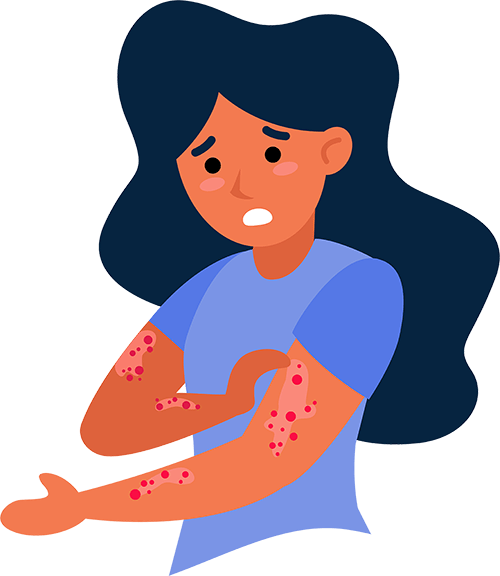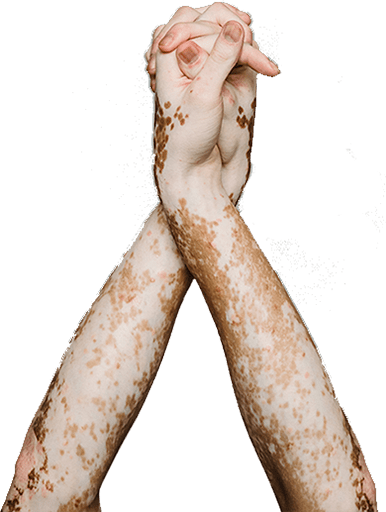Experience The Power Of Ayurved
Vitiligo Treatment
Treat with Ayurved from the comfort of your home.
Consultation on Call, Video Call, Zoom, Skype
At your preferred time
Personalised & Prakriti based treatment
Get medicines delivered at your doorstep
Book An Appointment
*Your information & privacy is secured!
What is Vitiligo?
We have a pigment present in our skin called melanin (it is also present in our hair and eyes). Melanin is responsible for the color and texture of our skin. White patches or Vitiligo or Leucoderma are caused by a gradual loss of melanin pigment. The skin loses its pigment cells (melanocytes) in Vitiligo. Different parts of the body can develop discolored patches, such as the skin, hair, and mucous membranes.
The Ayurvedic term for vitiligo is Shwitra or Shweta Kushta. According to Ayurveda, vitiligo results from an imbalance mainly of Vata and pitta polluting the skin, muscles, and fatty tissue. Vitiligo is regarded by Ayurveda as a chronic disease that is difficult to treat, but curable at an early stage.
Anyone can experience this at any age, but it is never contiguous.
What are the causes of vitiligo?
The exact cause of these pigment cells failing or dying is still a mystery to modern medicine. Possible causes include:
An autoimmune condition affecting the immune system
As a result of hereditary factors
An event that triggers stress, such as severe sunburn or chemical exposure
What are the causes of Vitiligo in Ayurveda?
According to Ayurveda, the following factors cause vitiligo (shwitra):
- Chardivegadharana (suppression of vomiting),
- Virudhahara (incompatible food)
- Atibhojanam (excess food consumption),
- lavanas, madhuras, katu rasa sevanm (to consume excessively sweet, salty, sour, or pungent food)
- navanna, dadhi, and matsyabhakshanam (to consume new grain, curd, or fish inappropriate intake)
- vipra-gurus gharshanam (to disrespect elders), papakarma (sinful acts)
What are the symptoms of vitiligo?
These are some of the symptoms of Vitiligo:
- Loss of pigmentation in the skin, usually starting on the hands, face, and around the genitals and body openings
- Greying or whitening of your hair prematurely, particularly on your scalp, eyelashes, eyebrows, or beard
- A change in the color of the tissues around your mouth and nose (mucous membranes)
Typically, it appears before the age of 30 but can start at any age.
There are different types of vitiligo. Depending on what type of vitiligo you have, you may experience these symptoms:
- The form of vitiligo referred to as universal vitiligo affects nearly all parts of the skin.
- Generalized vitiligo is the most common type, and it usually progresses similarly on corresponding parts of the body (symmetrically).
- Another type of vitiligo strikes at a very young age. It is called segmental vitiligo. It progresses for a few years and then stagnates.
- A localized (focal) vitiligo affects one or a few areas of your skin.
- Vitiligo affecting the face, hands, and body openings such as the eyes, nose, and ears is commonly called acrofacial vitiligo.

What are the Complications of vitiligo?
Vitiligo patients may be more susceptible to:
Anxiety or depression
Sun damage
Eye disorders
Loss of hearing
Why Ayurveda is a better option for vitiligo treatment?
The modern treatment for vitiligo mainly focuses on restoring the normal skin color through UV ray treatment. However, this treatment may have multiple side effects. Patients may experience skin color restoration after treatment for vitiligo. Nevertheless, it cannot prevent continued loss of skin color or a recurrence.
How Ayurveda treatment for vitiligo works?
There are three pillars of Ayurvedic treatment for vitiligo –
Ahar ( Diet )
Vihar ( Lifestyle )
Upchar ( Treatment )
Diet recommendations (aahar) for vitiligo
- Light meals are the best.
- Eat more rice, wheat, and green gram.
- Eat bitter gourd and ridged gourds as part of a healthy diet
- refrain from drinking alcohol and tea, especially those with strong flavors.
- Eat less sugar, white flour products, and denatured grains such as polished rice and pearled barley
- Veggie roots and tubers like potato, carrot, colocasia, and black gram should be avoided
- Refrain from eating canned or bottled foods and aquatic animals.
Lifestyle changes (vihar) for vitiligo
- Observe the rules of Sadvritta (behavioral and social codes of conduct),
- refrain from anger, hatred, misery, and negative thoughts.
- practice meditation and yoga daily
- have regular meal timing and sleep pattern
- Vratapoojapathadana (fasting, prayer, chanting the sacred hymens, donation, etc.)
- Go to pilgrimage sites or sacred places
Ayurvedic treatment (Upchar) for vitiligo
Body detox or purification is the first step in the Ayurvedic treatment of vitiligo. We recommend bio-purification therapies (panchakarma) and personal hygiene for a complete body detox.
Panchkarma procedures are used to “loosen and flush away Ama or metabolic toxins and undigested material)” and excess dosha from the various sites in the body. The important panchkarma treatment for vitiligo treatment include –
- Snehana (oleation)
- Svedana (fomentation or heat therapy)
- Vaman (therapeutic emesis)
- Virechana (therapeutic purgation)
- Raktamokshana (therapeutic bloodletting)
Ayurvedic home remedies for vitiligo
- Mix two spoons of mustard oil with one spoon of turmeric powder. After applying this paste to the area with white patches, let it sit for 15 minutes and then rinse with lukewarm water. Do this three to four times a day for significant relief in vitiligo.
- Prepare a paste of fresh neem leaves and sieve it to extract the juice. Consume one spoon of honey with one big spoon of neem juice three times a day.
- Mix two spoons of walnut powder with a little water to make a paste. Apply the paste to the stained area for 20 minutes, three to four times a day.
- Every day, consume cooked Bathua leaves.
- Wash the white spot three to four times a day with bathua water.
- Mix half a cup of sesame oil into two cups of raw bathua juice, cook it on a low flame until only oil remains, then pour it into a vial. Consume this preparation as frequently as possible.

Yogasana and pranayam for Vitiligo
- Treatment of vitiligo is made easier with kapalbhati. Through inhalation and exhalation, kapalbhati purifies the blood.
- As you breathe deeply and rhythmically, you release harmful toxins and keep vital systems functioning optimally. This pranayama also helps in balancing doshas.
- When you perform Uttanasana, or forward-bending poses, your blood flow increases, bringing oxygen and nutrients that fight free radicals and promote skin cell renewal.
- Utkatasana increases the circulation of blood throughout the body, causing the skin to sweat out toxins.
The information provided here is intended to help you find relief from Vitiligo. Please contact us if you would like a detailed personalized Ayurvedic treatment for vitiligo.
